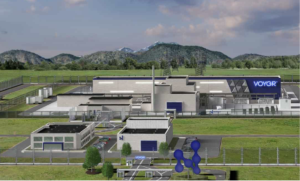
By Steve Haner
Standing firm against raising taxes is a fine thing, but it would help if Virginia’s leaders also stopped using people’s electricity bills to fund rent-seeking energy speculations.
Governor Glenn Youngkin (R) has tweaked, but not vetoed, pending bills that allow both of Virginia’s investor-owned utilities to charge ratepayers for power plants that may not be built. The dream projects involve small modular nuclear technology, proven in military applications but so far speculative for commercial generation.
The Governor’s proposed amendments (substitutes really, but not substantial substitutes) do not greatly enhance any consumer protection. In theory, the regulatory State Corporation Commission could refuse a future application to charge ratepayers, but it seldom thwarts the will of the legislature. Expect to see your bills raised in the next 18 months or so to pay for plants that may never be built.
During the session one of the concerns raised was that different bills with different rules would apply to Dominion Energy Virginia and Appalachian Power Company. That is where we have ended up. House Bill 1491 applies only to APCo with its 500,000 customers, and Senate Bill 454 applies only to Dominion and its 2.6 million customers. (You lucky rural cooperative customers escape again.)
The substitute versions will be voted on April 17 and there is no reason from the history of the bills to date (H1491 and S454) to expect they will fail. Neither will they be unanimous.
Youngkin has long been a cheerleader for this technology, and two years ago all but promised to push for such a reactor in APCo’s territory of Southwest Virginia. Election time promises like that blossom in that struggling economy like fruit trees, but recently Youngkin applied a killing frost. He told an audience out there that it was more likely to happen elsewhere in the state, and the language of the Dominion bill points to co-location with one of its existing nuclear facilities.
The traditional regulatory route is that a utility seeking to build a power plant gets the plan approved by the State Corporation Commission before charging anything to consumers. The advance exploratory planning is on the company’s dime, although it gets it back later. The game here is to charge ratepayers from the get-go as the project’s feasibility and costs are explored, a major abandonment of consumer protection principles.
In Dominion’s case, the bill sets a maximum consumer cost of $1.40 per 1,000 kilowatt hours, but doesn’t specify a cost cap. Many homeowners use way more power per month than that, and business customers will pay plenty, too. For Appalachian, the bill sets an overall cap of $125 million and an annual revenue recovery of $25 million per year. By way of comparison, APCo is also now seeking a base rate increase of $95 million per year.
These will be noticeable cost increases, but the kind of buried, hidden, hard to discern hits to consumers that keep legislators safe in elections. And if the plants are eventually built, and the power flows, all will be well. What could go wrong?
The different bills also have some variation in just how much can be spent before the utility must make a real go/no-go decision to apply for construction. And Dominion’s version, as it did earlier, authorizes a profit margin. Appalachian didn’t demand a piece of the action to undertake its gamble with ratepayers’ money.
The Dominion bill includes a phrase (C. Nothing in this section shall limit the Commission’s authority to approve or deny a petition for recovery of SMR project development costs….) which might have been inspired by an earlier Bacon’s Rebellion column. The same words do not appear in the Appalachian bill. It could just be window dressing anyway, as another critic of this bill responded when I wrote that.
The message here is that these projects are speculative, breaking new ground, and the utilities are loathe to risk any of their own stockholders’ money on the preliminaries. Dominion happily spends stockholder dollars planning solar, wind and gas plants, and even on the recent upgrades and relicense applications for its old nuclear plants. Why must ratepayers kick in early now? This is a flashing red warning light of risk.
The whole reason for the high profit margins guaranteed by law for these monopoly companies is that they take risks. Yet here the Virginia General Assembly goes again, shifting the risk right back onto its constituents. Every economics textbook in the world is getting a new chapter on regulatory capture.
Nuclear power checks the carbon-free box and is going to grow in popularity as electricity demand explodes and more people realize reliable baseload must expand along with wind and solar. There is very helpful legislation pending in Washington, in fact having passed the House. Delaware policy expert David Stevenson wrote about it for The Wall Street Journal. That would make this less speculative, but it has not passed the Senate and may never.

Leave a Reply
You must be logged in to post a comment.